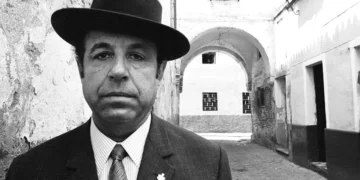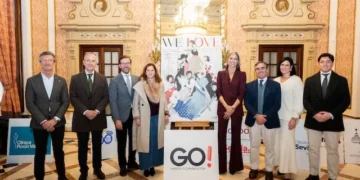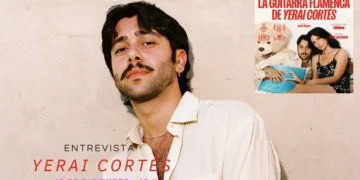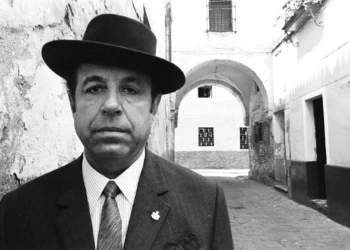|
| Coverage of the Festival Flamenco USA is sponsored by Arte Fyl Dance Shoes |
| Calzados de Arte Fyl: art for the Art Professionals know |
Text : Mona Molarsky
Contemporary take on flamenco for
the big stage
Dancers: Carmen Cortés, Alejandro Granados, Carlos Rodríguez
& Rocío Molina. Guitar soloist: Gerardo Nuñez.
Other guitarists: Rafael Rodríguez & Paco Cruz. Vocalists:
David Lagos & Jesús Méndez. Percussion: Nacho
Arimani. Saxophone: Perico Sambeat. Stage director: Jacqulyn Buglisi.
Music director: Gerardo Nunez. Costume Designer: Miguel Adrover.
Lighting Designer: Clifton Taylor
There wasn't a spare ticket to be had on Friday night,
when the red velvet curtain went up on the Flamenco Festival New
York's production of «The Four Elements.» City
Center Theater, a 1920s neo-Moorish confection where prima ballerina
Maria Tallchief once danced with the New York City Ballet, was packed
with the usual New York dance crowd. The audience was decked out
in everything from mink coats to denim and t-shirts. Along with
English and Spanish, snippets of Russian, German and French ricocheted
off the art deco walls. But few of New York's flamencos were to
be seen in the crowd. Some of the lucky ones had attended the sold-out
Four Elements Gala the previous evening. Others were saving
their dollars for the Enrique Morente, Tomatito, Carmen Linares
and Diego Carrasco performances coming up in February.
But New York's dance devotees, who tend to be as fluent in Martha
Graham, Merce Cunningham and Alvin Ailey as they are in Marius Petipa
and George Balanchine, were wildly appreciative of the four fine
artists who presented a contemporary take on flamenco for the big
stage.
The curtain rose on a vast, dark space–more desolate SoHo warehouse
than sociable bar in Madrid. Four black-clad figures huddled on
stools in the spotlight. They pounded their heels in a stark, Mario
Maya style introduction, as if to say, «We are here as percussionists!
Drumming is the global language!»
Rising, they stretched their long white arms toward the rafters,
abruptly contracting stretched-out fingers into fists. They fell
into off-center turns–a la Martha Graham–their pale faces, masks
of angst. Upstage left, the guitarists, singers and palmeros
hovered like ghosts in the murky distance. So we, the audience,
were put on notice. Tonight's flamenco would be an expression of
loneliness, a parable of four separate planets, each whirling through
space in its own cold orbit.
An up-to-the-minute technological feel
that was at once fascinating and distracting…
 |
 |
|
|
Carmen Cortés
|
Rocío Molina
|
Alejandro Granados
|
Photos: © Javier Suarez
This opening statement gave
way to a lyrical guajira. Rocío Molina, wearing
liquid blue that broke into a pale froth of ruffles, personified
the element of water in a tribute to flamenco's transatlantic influences.
Her soft, white arms were fluid and feminine. Her round hips evoked
the plentitude of seaports: from her native Málaga to old
Havana. The bata de cola of her gown followed her body
like water pouring off a swimmer. Guitarist Paco Cruz was equally
in his element with this lacy, Latin showpiece. Projected behind
the dancers, shimmering images of water gave the production an up-to-the-minute
technological feel that was at once fascinating and distracting.
But Molina's tour-de-force was greeted with enthusiastic applause
and shouts from the audience.
Next, onto the modernist Cuban beach stepped Alejandro Granados,
dressed in the red-brown earth tones of Andalusia. He moved through
a languid duet with Molina, his gaze fixed on a distant point. The
two didn't speak or even seem to see each other. They were, after
all, different elements, dancing on different continents.
As Molina floated off stage, the sounds of tribal chanting rose
through the theater's sound system. Evoking both African slave song
and Native American pow-wow, the sounds swelled then faded into
the live rhythms of a huge tom-tom, played by percussionist Nacho
Arimani. So began a «seguiriya» for the twenty-first century.
And by taking this most profound and purely Gypsy part of the flamenco
tradition and re-imagining it as a generic tribal expression, these
artists seemed to choose the seguiriya's universality over
its unique, distinctive power.
Granados danced, his somber face tilted up toward the heavens,
searching, perhaps, for God. He is the consummate dancer, masculine
but not menacing, at one with the music; his compás is as
natural as the rain. And if his seguiriya, danced to the
guitars of Paco Cruz and Rafael Rodríguez and the song of
David Lagos and Jesús Méndez, lacked the emotional
intensity of the truly great seguiriyas, it's hard to blame
anyone. This precise form was born in the metaphorical plains of
Andalusia, in front of a campfire's embers, where a lone Gypsy faced
the abyss of midnight. Few artists have managed to take the seguiriya
out of its natural habitat and give it life on the big New
York stage. The klieg lights alone are enough to extinguish its
fragile beauty.
Granados' Seguiriya was followed by a bluesy Nana,
or lullaby, danced by Rocío Molina and Carlos Rodríguez,
accompanied by Perico Sambeat's saxophone. As if spilling from the
mouth of the sax, a smoky yellow serpent slithered across the back-lit
screen, while Rodríquez, in white, partnered Molina, in blue.
Rodríguez, who personified air, is small, wiry and
in perfect control, a young cat leaping from chair to table. As
the palmeros clapped in syncopation, Rodríquez spun
through a series of perfect pirouettes and chaînés,
displaying his ballet training to impressive effect. With the bravura
of a young Antonio Gades, he then danced, arms akimbo. His rapid-fire
taconeo was like flint striking sparks off the floor. As
Granados had, he partnered Molina coldly, rarely meeting her eyes;
a brilliant asteroid, following his own private trajectory.
That mysterious power that makes
somebody give up hearth and home for the uncontrollable magnet of
flamenco
The vituostic guitar of Gerardo Núñez was showcased
in a musical interlude. Núñez possesses an
incredible facility and weaves a fine Belgian lace out of tremolos.
I suspect that most in the audience, who were not guitarists themselves,
let their minds wander elsewhere during his elegant solo. Aficionados
of guitar technique, however, must have been suitably awed.
Spirited Tangos danced by Granados and Rodríguez
and accompanied by Paco Cruz on guitar, offered another opportunity
to admire both men's grace and ease, and led into a sensual soleá
performed by Carmen Cortés, wrapped in red silk and fringe,
as the element of fire. Of the four dancers, Cortés is the
most traditionally flamenco. Accompanied by Núñez
on guitar and Lagos' and Méndez's vocals, she seemed to embody
the soleá. Her firm, lithe arms were a vision of
beauty. A blaze of yellow satin underskirts licked through the red
fringe at her ankles. For once, the audience was in danger of being
swept up in the pull of the music. This, after all, is what it's
all about. That mysterious power that makes somebody give up hearth
and home for the uncontrollable magnet of flamenco. This is the
thrilling moment, the moment when the fiesta begins to take shape.
If only there could have been more of it!
All too soon, the fin de fiesta arrived. A jazzy bulería
led by Sambeat's sax. While golden flames were projected over their
heads, the four dancers presented themselves in their final flamenco
tour de forces. For the first time, a smile spread across Granados'
handsome face. Were we having fun yet? Well, OK–at last!
by Mona Molarsky @2005. All rights reserved.
|
Gerardo Núñez |























